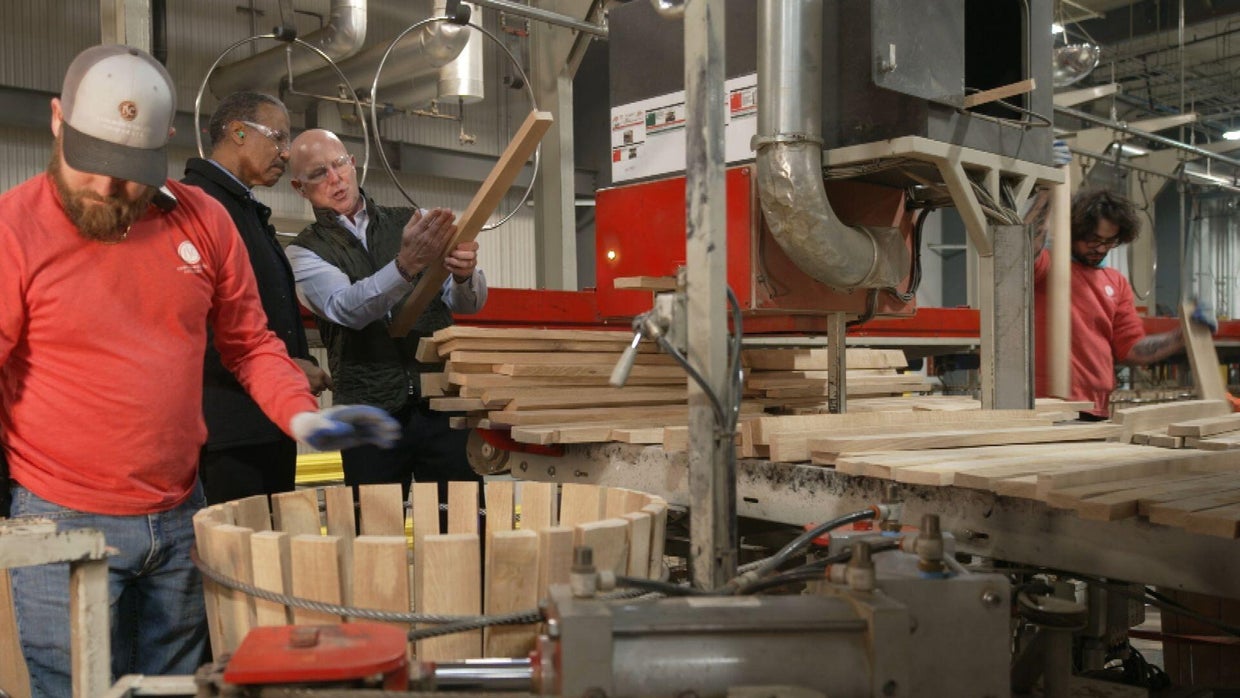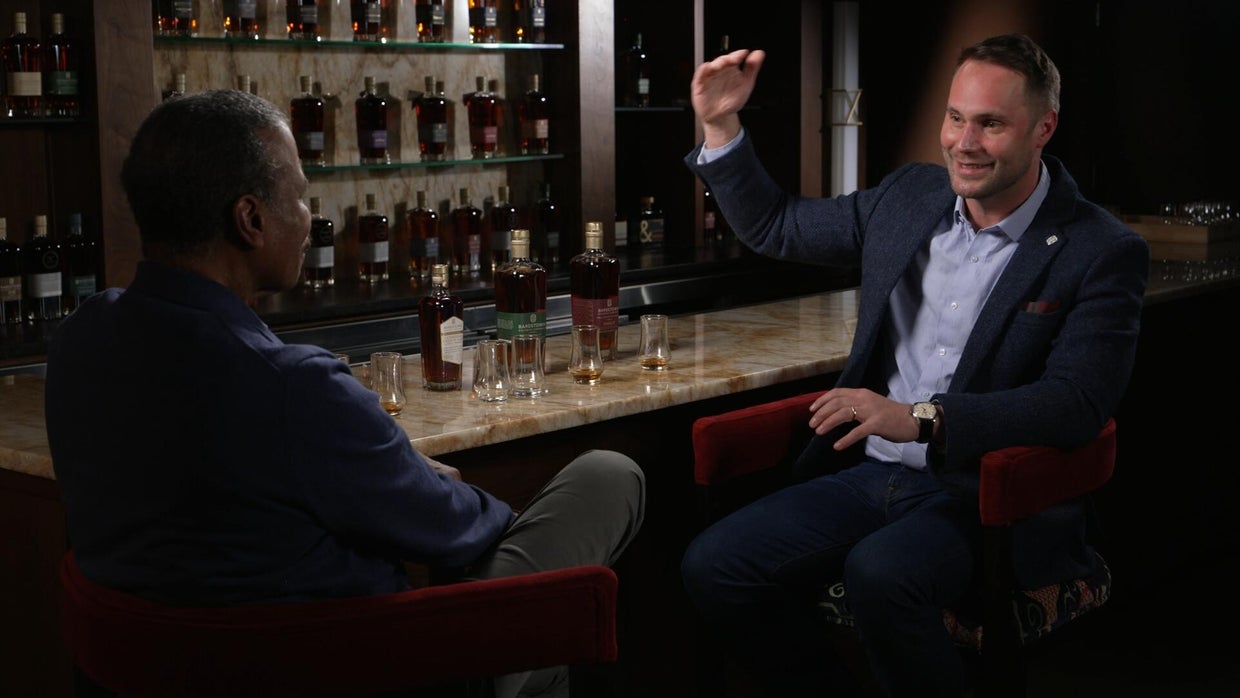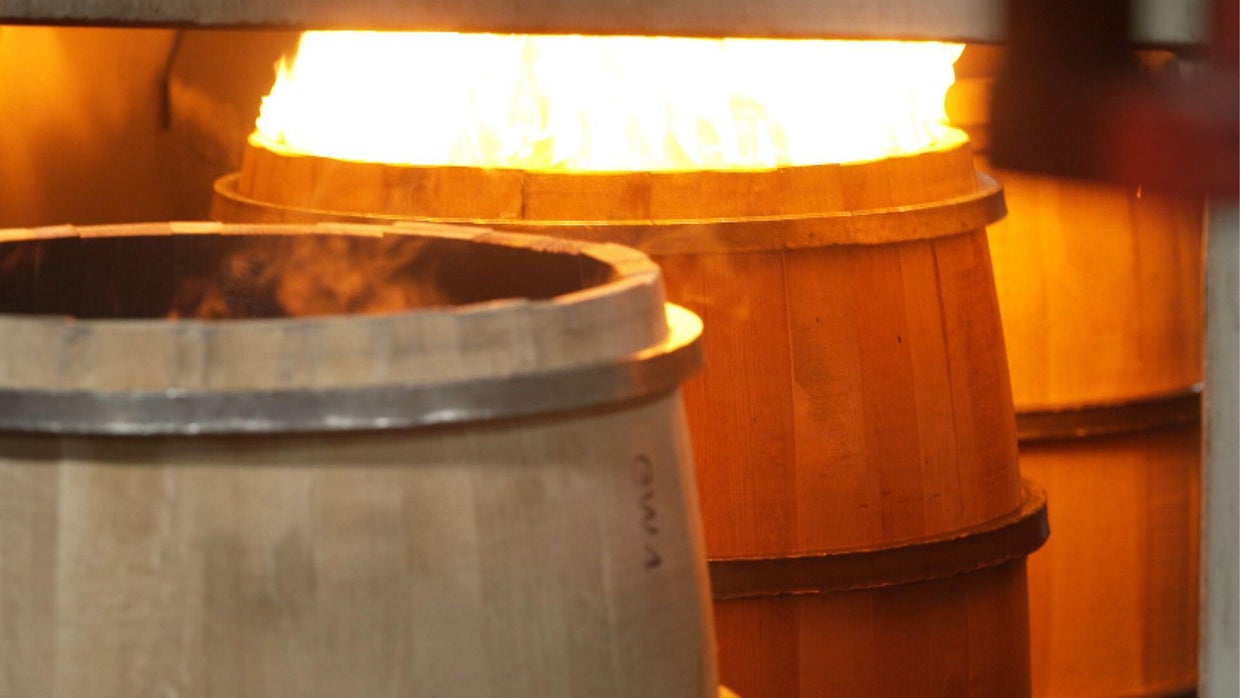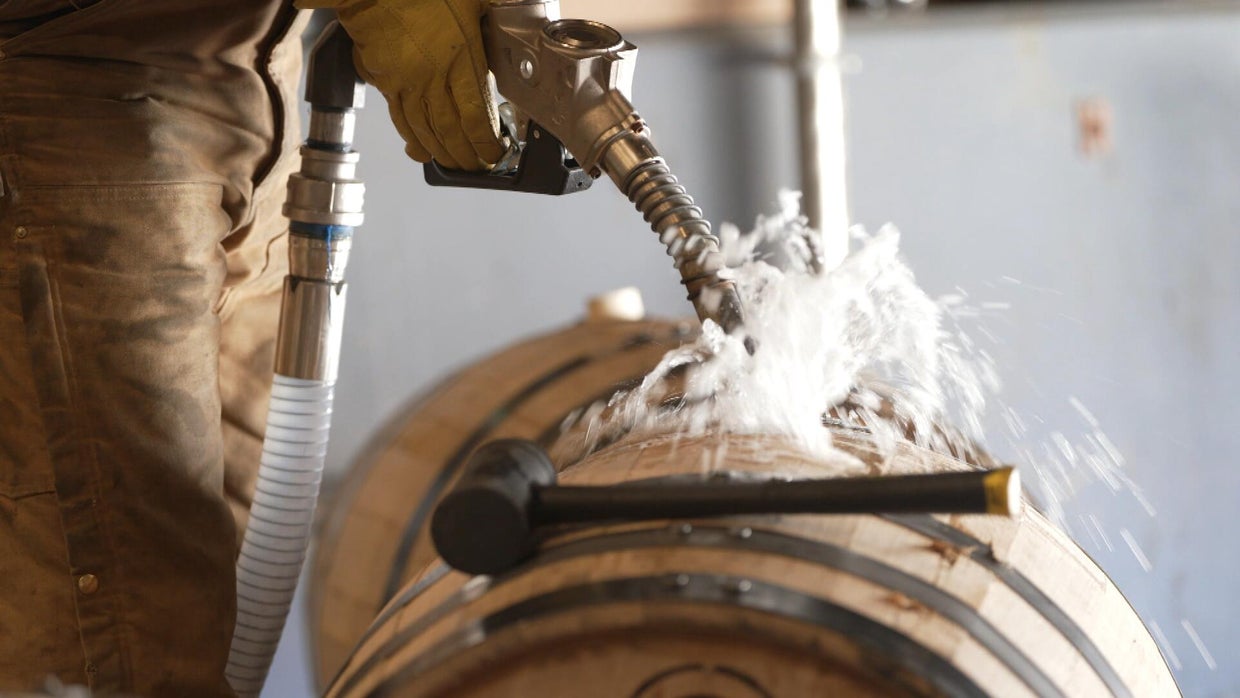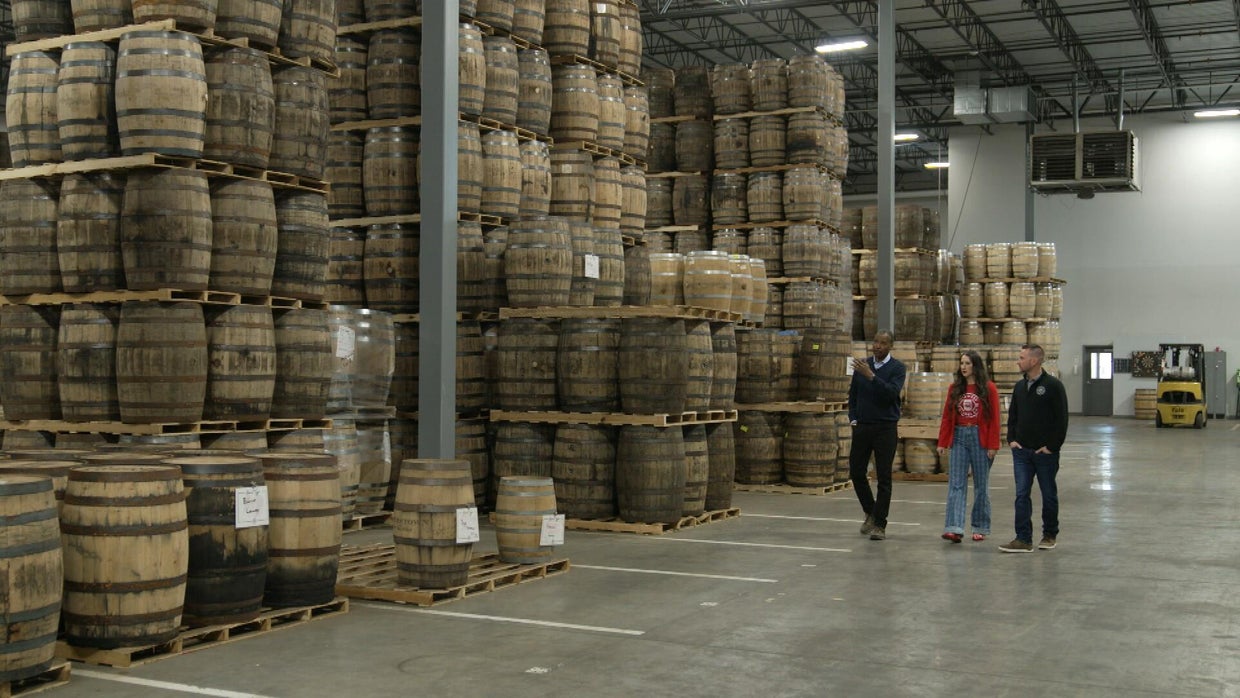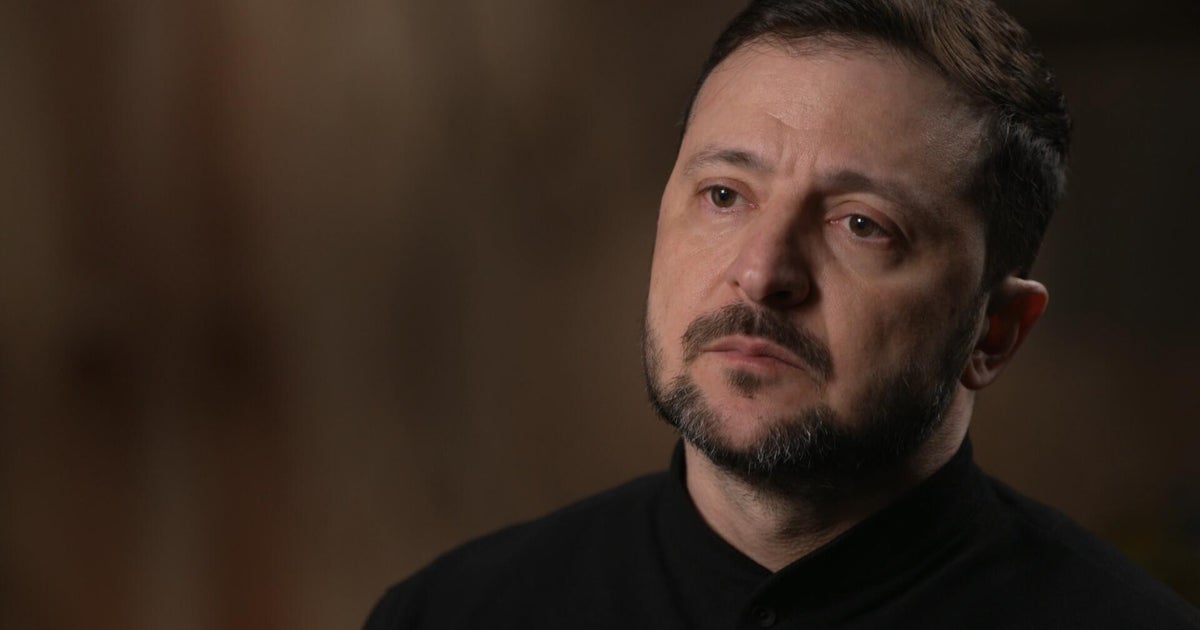Bourbon barrels enjoy second and third lives around the world, where they're used to age other spirits
If someone asked you to name a product that was first made 2,000 years ago, still looks and works as it always has, and still plays a vital role in global commerce, would you be stumped?
It turns out, the answer is the simple wooden barrel. Almost always made of oak, barrels have a long and fascinating history. First built and used by the Celts and Romans, they have held nearly every commodity over the centuries.
Metal and plastic and cardboard long ago eclipsed barrels for the shipment of most items, but when it comes to wine and whiskey – especially bourbon whiskey – the oak barrel still reigns, not just as a container, but for the magic that the wood gives the whiskey.
Bill Whitaker: Well we were speaking with someone. And they called a whiskey barrel a breathing time machine.
Brad Boswell: I love that.
Brad Boswell is the CEO of Independent Stave, the largest maker of wooden barrels in the world. Brad's great-grandfather founded the company in 1912 in Missouri. It now has operations worldwide; we met him in Kentucky.
Brad Boswell: Most of our barrels would have useful lives of 50+ years.
Bill Whitaker: Fifty plus years.
Brad Boswell: Fifty plus years, yeah. Like, I'll go to different places and look at barrels at distilleries or wineries around the world. And I can see barrels that my grandfather made, you know, in the 1960s. I still see 'em.
A barrel begins as a log from a white oak tree fed into what's known as a stave mill, where it's cut into ever-smaller pieces – staves – which are then arranged in huge "Jenga"-style stacks and "seasoned" outdoors for three to six months before heading to a nearby "cooperage," where the barrels are built.
Brad Boswell: There's no nails, look over here, no glue --
Brad Boswell's newest cooperage produces thousands of barrels every day.
Bill Whitaker: How many of these go into a typical barrel?
Brad Boswell: Typically between 28 and 32 staves per barrel.
After a barrel is "raised" mostly by hand, it travels through a host of other steps and checks to make it ready to begin its life, including being toasted and then charred on the inside.
Brad Boswell: Most of the barrels we make today are bespoke. We know exactly who this barrel's going to, which distillery.
Bill Whitaker: How about that. How about that.
The demand for such a huge volume of barrels can be attributed mainly to one thing: bourbon.
Brad Boswell: President Franklin Roosevelt in the '30's became more specific about what bourbon whiskey should be. And at that time he said, you know, bourbon should be in new charred oak barrels.
Bill Whitaker: So if it's not in one of these barrels, it's not bourbon?
Brad Boswell: That's correct. Bourbon has to be aged in a new charred oak container.
That rule, plus booming consumer demand for bourbon starting in the early 2000's, has been very good for the barrel business. 3.2 million new barrels were filled with whiskey last year in Kentucky alone, and more than 14 million full barrels are aging in the state, in massive warehouses known as rickhouses.
Bill Whitaker: How many-- barrels are in this rickhouse?
Dan Callaway: 23,500 on six floors.
Dan Callaway is the "master blender" for Bardstown Bourbon, a young but fast-growing Kentucky distillery.
Dan Callaway: To make a great whiskey you have to start with a great distillate, a clear spirit. But then the magic comes from the barrel. The fact that it's new charred oak, it's just incredible.
Bill Whitaker: So the-- the barrel is-- is crucial to your product?
Dan Callaway: Absolutely. Depending on who you talk to-- some would say 50% of the flavor, maybe up to 70-80% of the character is derived from that barrel.
The rest of the flavor comes from what's known as the "mash bill," grains like corn and wheat and rye that are mixed with water and fermented with yeast.
Despite bourbon having recently been threatened or hit with tariffs by other countries in retaliation for President Trump's tariffs, Bardstown's huge distillery is still producing enough new whiskey to fill more than 5,000 barrels a week.
Bill Whitaker: You take the-- the clear liquid, which is basically what people call "moonshine," goes through this process and comes out as this beautiful brown, tasty liquid here. How does that happen?
Dan Callaway: Yeah, so I always compare it to a seesaw, okay? So when it comes off the still-- moonshine, like you said-- it's a seesaw that's out of balance. But every year that goes by of the barrel aging, the seesaw comes into balance. And what the barrel is bringing is caramel, vanilla, baking spice - and all this rich, beautiful color.
How can solid oak produce all those flavors and spices? Back where the barrels are built, Brad Boswell gave us a vivid lesson with a barrel that had just been toasted — a process that brings sugars in the wood to the surface.
Brad Boswell: Smell that. Smell that. I mean-
Bill Whitaker: That does smell delicious.
Brad Boswell: It's incredible.
Bill Whitaker: It really does. It's amazing.
Brad Boswell: There's a reason why people still use oak barrels 2,000 years later.
Bill Whitaker: So when I'm sipping the bourbon, I'm sipping this barrel.
Brad Boswell: That's right, absolutely.
After toasting, we, and the barrels, moved to the visually stunning "char" oven.
Brad Boswell: So we'll see this barrel coming through right here.
Bill Whitaker: Oh, look at that.
Brad Boswell: Yeah. So actually, the inside of the barrel is on fire.
Bill Whitaker: They just light the barrel on fire?
Brad Boswell: Yup, we light the barrel on fire, and that teases out more and more of the flavors. And we call that an alligator char, 'cause the inside of the barrel actually looks like kind of an alligator's back.
We could see that blistering inside a newly-charred barrel pulled off the line.
Brad Boswell: I mean people, you know, expect this to smell like a campfire. It smells more like a confectionery product.
Bill Whitaker: It does-- I can smell the caramel and the vanilla.
What that barrel can give to the whiskey is evident in these glasses.
Brad Boswell: So this is the same exact distillate that came off the still at the exact same time, went into a barrel. Four years later. And this we just kept in a glass bottle.
It's also apparent in the taste. First, the white lightning…
Bill Whitaker: Wow, that gives a punch.
Brad Boswell: Yes, it does, it does.
…and then the barrel-aged bourbon.
Bill Whitaker: Oh, big difference.
Brad Boswell: Huge difference.
Bill Whitaker: It's smooth.
Brad Boswell: Oh, it's smooth.
Some of that smooth comes from temperature swings in the rickhouses, according to Bardstown Bourbon's Dan Callaway.
Dan Callaway: We want those swings. When it-- you know, when it gets really hot, things expand, lets the liquid in. When it gets cold, it contracts. And it's that natural progression of in out that ages the bourbon so beautifully as the liquid interacts with the wood.
As those barrels are aging whiskey for four, five or six years, some savvy investors have figured out there's money to be made!
Chris Heller: Whiskey is an interesting asset, in the sense that as it ages, it becomes more valuable.
Chris Heller is co-founder of California-based Cordillera Investment Partners.
Bill Whitaker: So, explain to me how this works. You-- you go up to a distiller and say, "I want to buy those barrels filled with what will eventually become bourbon"?
Chris Heller: So, that is exactly right.
Heller and his partners buy thousands of newly filled barrels from distillers, pay to store them as the whiskey ages, then sell them to craft bourbon brands.
Bill Whitaker: What are your starting costs?
Chris Heller: Somewhere in the $600 to $1,000 range is sort of the price of a new-- what's called a new-fill barrel of whiskey.
Bill Whitaker: At the end, what do you sell it for?
Chris Heller: It can be anywhere from $2,000 to $4,000, by the end.
Bill Whitaker: That's a pretty good return on your investment.
Chris Heller: We really find it an interesting and compelling investment area.
Bill Whitaker: Nice way to say it.
Whoever makes it, owns it, or ages it, when bourbon is emptied from a barrel after five or six years, that barrel's life is just beginning, and it's likely to travel the world.
Brad Boswell: It's real interesting that when the bourbon barrel is freshly dumped, there's still around two gallons of actually bourbon trapped in that wood.
Bill Whitaker: That has just seeped into the wood?
Brad Boswell: That's seeped into the wood. So then, a lotta the secondary users actually look forward to putting their product into the barrel again for four, six, ten, a lotta scotches 12 years, 18 years--
Bill Whitaker: And it can pick up that American bourbon taste?
Brad Boswell: Absolutely. Then it pulls out that sweet bourbon.
That sweet taste in the wood makes used bourbon barrels very hot commodities.
Jessica Loseke: We really view our role in the industry as moving as many barrels from the original source to the next stopping point as fast as possible.
Jess and Ben Loseke own Midwest Barrels. Their Kentucky warehouse is stacked to the rafters with empty barrels.
Ben Loseke: So we're the next stop for the second use of that barrel. So in Kentucky here, we bring in barrels from all the major distilleries and then send them back out.
Bill Whitaker: These barrels would be shipped out and then refilled with something else?
Ben Loseke: Correct, yeah. So the idea is to get these barrels in here and out of here as quickly as possible. So we'll turn over this entire warehouse every two to three weeks.
Ben Loseke: Probably 70 to 80% of our business is overseas.
It started as a hobby. While Ben was finishing his PhD in Nebraska, he began buying barrels, and selling them to local craft breweries.
Bill Whitaker: You said that a few barrels-- were a big order in the beginning. (LAUGH)
Ben Loseke: Yeah.
Bill Whitaker: What's a big order today?
Ben Loseke: 10,000.
Bill Whitaker: 10,000?
Ben Loseke: Yeah, yeah. India, and China, and Scotland, and Ireland are, by far, our four biggest markets.
The Kentucky Distillers' Association says that the state exported more than $300 million worth of used barrels last year…just to Scotland, where they'll be used to age scotch whisky for up to 40 years!
Bill Whitaker: Could you just tick off for me the different spirits that these barrels will hold?
Brad Boswell: They start with bourbon, Tennessee whiskey, scotch whiskey, tequila, rum, pisco made in Peru, cachaça made in Brazil will use these barrels.
Bill Whitaker: Beer.
Brad Boswell: Beer uses them. These barrels for sure end up in China. A lotta these barrels end up in Japan. It's --it's everywhere.
Dan Callaway: Beautiful.
Now, master blenders like Bardstown's Dan Callaway –
Dan Callaway: This will be cask strength, direct from the barrel.
— Are bringing barrels back to Kentucky to do special "finishes" for their whiskeys.
Dan Callaway: So this is the first of its kind. It is an American whiskey finished in Indian whiskey barrels. Okay. Indian whiskey is traditionally aged in a bourbon barrel. So the physical barrel has left Kentucky, gone to Bangalore, filled with a -- a barley and then sent back here.
Callaway finished this whiskey in those barrels for 17 months.
Bill Whitaker: My God, that's good.
Dan Callaway: Yeah.
Dan Callaway's newest creation, called Cathedral, may be his most miraculous yet.
Dan Callaway: We sourced wood in the Loire Valley, the Bercé forest. And this plot, this lot in the forest was selected to repair Notre Dame after the fires. So most of the wood went there. We were fortunate to obtain six barrels made from that wood. And we picked our-- our best stocks of Kentucky bourbon up to 19 years old. Filled the barrels. They age for 14 months.
Bill Whitaker: You know how wild that is?
Dan Callaway: Yeah.
Bill Whitaker: That the beams that restored Notre Dame come from the same forest as your casks?
Dan Callaway: The same lot.
Bill Whitaker: Now that's a story to tell.
Dan Callaway: Absolutely.
…and a whiskey to taste.
Bill Whitaker: Ahhh.
Dan Callaway: It's nice.
Produced by Rome Hartman. Associate producer, Matthew Riley. Broadcast associate, Mariah Johnson. Edited by Craig Crawford.


